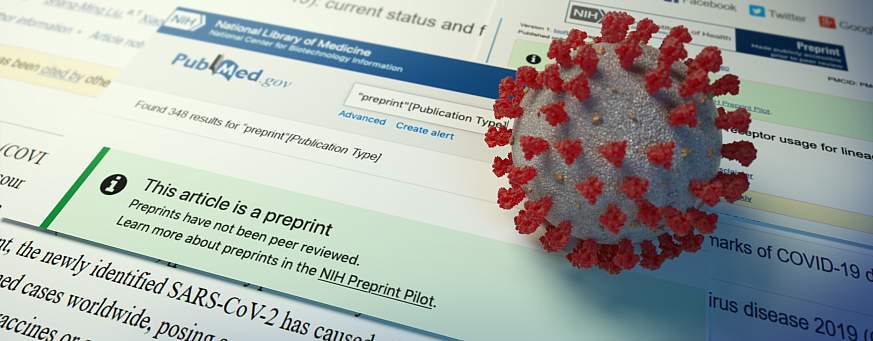You are here
August 19, 2020
Making Effective Use of Preprints
Tips for Communicators

By Jerry Sheehan, Deputy Director, NIH’s National Library of Medicine (NLM) and Kathryn Funk, MLIS, Program Manager for NLM’s PubMed Central.
Preprints are gaining considerable attention lately as biomedical researchers seek to quickly disseminate the latest research findings related to COVID-19, the disease caused by the novel coronavirus. Posting preprints to public repositories is not a new practice in science. Scientists in other disciplines, such as physics, have followed this approach for decades. But wider adoption in the biomedical sciences is more recent.
Preprints are research manuscripts that have not been formally published nor critiqued and refined through the peer review process. When made publicly available, they can play an important role in accelerating the dissemination of emerging research. The COVID-19 pandemic has brought early research results shared in preprints to the forefront, and coverage of preprints in the news has also increased.
The tradeoffs between the timeliness of preprints and the additional scrutiny of peer review prior to formal publication pose a challenge for scientific communications. These tradeoffs are especially important in clinical research, where findings may be used to inform patient care. Peer review is critically important to ensure that experts can examine the study design, data collection processes, analytical approaches used, and quality of conclusions drawn.
Comparing preprints to the final publication can shed light on the scientific process. Ideas and hypotheses are tested and refined over time as other experts give expert feedback and critiques. This is science at work, not necessarily bad science. Yet, the traditional peer-review process takes time. Months may elapse before research findings are formally published in a journal.
New findings and data disseminated in preprints can easily grab readers’ attention, but acting on research summarized in preprints requires caution. In an unprecedented and developing situation like COVID-19, preprints can provide needed information quickly. But they can also potentially result in coverage of results that are misleading or not sufficiently qualified.
Recently, the National Library of Medicine (NLM) at NIH launched the NIH Preprint Pilot to test the viability of making preprints searchable in PubMed Central (PMC), a widely-used digital archive of full-text articles. These preprints, which report on research supported by NIH, are also discoverable in PubMed, a database with more than 30 million citations and abstracts of biomedical literature. Phase one of the pilot specifically focuses on preprints relating to the COVID-19 pandemic.
The primary goal of the NIH Preprint Pilot is to make it easier to find preprints developed with NIH support. This effort builds on guidance released by NIH in March 2017 that encourages researchers to use interim research products, such as preprints, to accelerate dissemination and increase the rigor of their work.
While preprints provide early and unrestricted access to research outcomes, health and science communicators need to apply a critical eye to the ways they interpret and report this information. It’s important to clearly differentiate between preprint and formally published findings. Here are some things to remember:
- When citing preprints, be clear about it. Preprint records in PMC and PubMed are flagged with large banners that clearly identify them as preprints. These reported results have not undergone the scrutiny of peer review, and the methods reported have not been thoroughly critiqued. Remind your audience of this to avoid potential misunderstandings or misleading statements.
- Approach preprint findings with a skeptical eye. Treat them at least as carefully as you would other sources of health and scientific information, including peer reviewed papers, presentation information, or official correspondence. Follow up and ask for expert opinions and interpretations to clarify and explain.
- Continue to check if the preprint has been revised or published. Preprints may be updated in response to comments received or further examination by the authors. (Note: Preprint records will be clearly linked to later versions of the paper in PMC and PubMed when available. The preprint record will not be removed from the archive when a later version is available.)
- Don’t be tempted by the allure of a single study. Avoid reporting publications in isolation. Make sure you look at other available knowledge and information. Each study is part of a larger base of knowledge, so be wary of any preprints that deviate from previous findings. Admittedly, this can be harder to discern with a new disease, like COVID-19, but even this disease has well-studied predecessors such as Severe Acute Respiratory Syndrome (SARS), Middle East Respiratory Syndrome (MERS), and other coronaviruses. PMC has tens of thousands of freely available full-text articles on coronaviruses.
- Remember that preprints only relay preliminary information. This is even more significant when reporting on research that describes treatments. As health communicators, it’s important to maintain public trust in research. Minimize reporting that might encourage clinicians or patients to make health decisions based on an individual preprint.
There are other resources that can help journalists make good use of preprints. For example, check out this tip sheet created by the Journalist’s Resource that address six key things to keep in mind about preprints.
We also encourage you to review the NIH Preprint Pilot overview and related FAQs for more information.
Today, more than ever, preprints are emerging as a key part of the research ecosystem. While preprints connect researchers, communicators, academics and lay audiences to encourage innovation, they must be interpreted and communicated with due care and attention.
